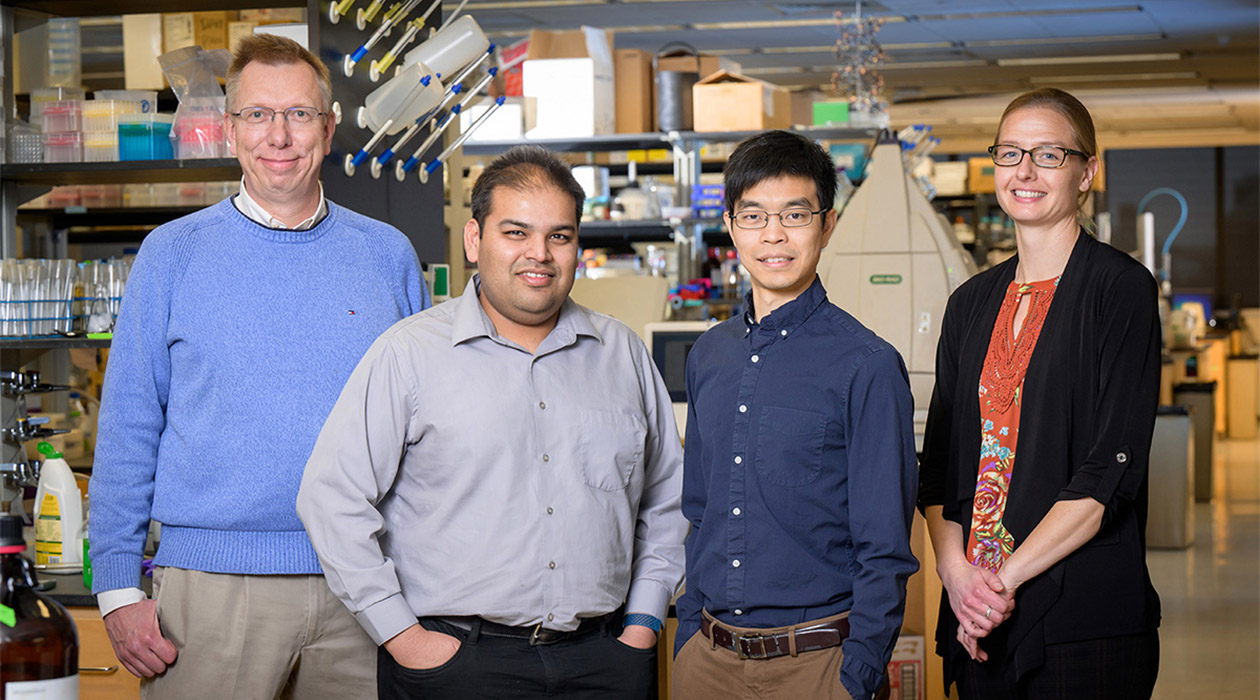$9.5M award to study emerging pathogens, better understand influenza-antibody interactions

From left to right, Wilfred van der Donk, Angad Mehta, Nicholas Wu and Beth Stadtmueller will receive $9.5 million over three years through Howard Hughes Medical Institute’s Emerging Pathogens Initiative. / Fred Zwicky
Aquatic birds, especially ducks, can carry influenza viruses but they don’t often become severely ill, leading scientists to wonder how their immune systems act as a reservoir for a highly infectious and pathogenic virus, but the birds remain relatively unharmed. Additionally, could the immune system be engineered to thwart transmission to other animals and humans, ultimately preventing future pandemics?
Four faculty at the University of Illinois Urbana-Champaign, plus a collaborator in Colorado, will attempt to answer these questions as part of an ambitious, three-year project funded by the Howard Hughes Medical Institute. HHMI will provide $9.5 million over three years to the UIUC and Colorado project, which was one of 13 selected by the institute as part of its $100 million Emerging Pathogens Initiative.
“We are optimistic that this initiative will help these scientists develop new, untested approaches that can reveal how pathogens work and how the human immune system responds to pathogen infection,” said HHMI Vice President and Chief Scientific Officer Leslie Vosshall in a release announcing projects funded by the Emerging Pathogens Initiative. “With this program, we hope to gain some of the knowledge and tools we need to get a scientific head start on future epidemics.”
Avian influenza outbreaks have been reported around the world for more than a century. The highly pathogenic H5N1 virus, first identified in 1996, can cause severe disease and has a high mortality rate in humans. If the H5N1 virus were to mutate and become easily transmissible from person-to-person while maintaining its ability to cause severe disease, the consequences for public health could be very serious, according to the World Health Organization.
“There are a lot more influenza viruses in birds than there are in humans, and so there’s a lot more variations. When the viruses spill over (to other animals or humans) they’re incredibly lethal and so that’s not something we want to see happen,” said Wilfred van der Donk (MMG), Richard E. Heckert Endowed Chair in Chemistry at UIUC and an HHMI investigator since 2008.
The Illinois and Colorado team includes UIUC biochemistry professors Beth Stadtmueller (MMG) and Nicholas Wu (IGOH/MMG); chemistry professors Wilfred van der Donk and Angad Mehta (MMG); and Jenna Guthmiller, assistant professor of immunology and microbiology at the University of Colorado Anschutz Medical Campus.
The work and the platforms developed by the group in the coming years will be applicable to other avian viruses or other host-virus relationships scientists want to better understand and prevent from spreading, added Beth Stadtmueller. She investigates the structural, biochemical, and biophysical mechanisms of proteins and complexes involved in immunity.
The group’s first aim is to develop ways to purify antibody-producing cells from ducks to get a better understanding of their antibody repertoire. Nicholas Wu, Jenna Guthmiller, and members of their labs will extract immune cells from the blood of ducks, sequence the antibodies and characterize them, ultimately assembling a pool of antibodies that researchers find worth further investigating. They will determine, for example, how many different strains of influenza an antibody could neutralize and how effectively those antibodies could neutralize the virus.
"Nothing much is currently known about the antibody repertoire in ducks. So, we are excited to have this opportunity to xplore its molecular features and potentially leverage them to address public health issues,” said Nicholas Wu, hose research focuses on understanding virus-antibody interactions.
Angad Mehta and members of his lab will then take observations from Wu and Guthmiller’s sequencing work and translate them into human systems. Mehta, the T.M. Balthazor Faculty Scholar and Assistant Professor of Chemistry, uses synthetic biology for evolutionary studies and for developing novel therapeutic strategies.
“We will use the information gathered and combine it with evolution platforms in human cells to study how the duck antibody sequences evolve. We’ll also engineer and evolve these antibody sequences to make human antibodies. Overall, our efforts could inform biologics development, diagnostics, and vaccine design,” Mehta said.
The influenza virus enters its host through mucosal routes, e.g. the nasopharynx and lungs and gut. Researchers will undertake several different engineering approaches to address the myriad ways the influenza virus invades its hosts. Stadtmueller and members of her lab are especially interested in mucosal antibodies.
“The antibodies secreted into those regions have unique and poorly understood structures,” she said. “We’re interested in building knowledge on mucosal antibody structure-function relationships and understanding their effects on various types of mucosal antigens. … In targeting flu, we’re really excited thinking about how these structures can support clearance of viruses and also how they’re functioning in the nasopharynx and lungs as opposed to the gut.”
The business part of antibodies is a series of loops that are hypervariable, and our immune system selects the ones that bind tightly to a molecule of the pathogen, van der Donk explained. Those loops could be mimicked with circular peptides, thus creating antibody-like molecules. His lab created a library of two million polycyclic peptides.
In 2018, “we were able to fish out of the two million, peptides that prevented the interaction between an HIV protein and a human protein,” he said. “In essence, we’re aiming to accomplish the same thing here, but we’re trying to prevent the interaction between an influenza protein and human proteins.”
The information obtained regarding the antibodies from ducks and human cells could be used to design the cyclic peptides against avian influenza, van der Donk said.
Ultimately, the implications for their work could extend beyond influenza. The antibody evolution and engineering platforms developed during these studies are expected to be “modular,” Mehta said, so they can be readily repurposed for targeting other emerging pathogens. In addition, these platforms can be potentially adapted to develop biologics for treating other diseases like cancer.
